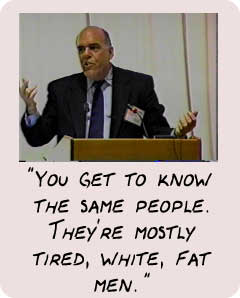|
|
Katalina Groh, Larry Prusak: Some of the world's leading thinkers |
| Storytelling: Organizational Perspective: Larry Prusak |
 |
Where
are all those people flying to?
I’ll tell you a very
brief story before I have to get off the stage here. About a year ago,
I take that shuttle constantly from Boston to New York. There’s a shuttle
plane. It starts at 6 a.m. and it ends at 10 p.m. I’ve been on all of them.
You get to know the same people. “Hi, how are you?” They’re all tired,
white, fat men mostly.
|
| But I decided to do something
different. It was sort of early to go to the office. And I started to do
something that I’ve wanted to do for years. I asked all these people where
they were going. I had a suit on, a tie, I was pretty harmless looking.
I’d say, “Hi. How are you? I’m Larry Prusak. I with IBM. Where are you
going?”
Some people knew who I am. Others said, “What? IBM? Are you selling something?” And I said, “No, I just want to know where you’re going.” About half the people are going to internal meetings. Now there are big lines and you get better answers because they’re tired. About half those people are going to internal meetings. Internal meetings. About half, by and large. And they’re from organizations that have all the technology they could buy. So they have video-conferencing. They have it all. This is Fidelity, the big bio-tech companies, some of the big hospitals, the big universities, they have it. You name it, they buy it and they have it. How come they are going to meetings? So I asked them. “How come you’re going to meetings? You have all this technology. How come you’re getting on this plane. It’s early, it’s expensive. It’s a pain in the butt. New York City gives you a headache. Why are you doing this?” And it was interesting. Because they’d say something like, “Well, I just have to be there.” “But why?” I kept probing. “Why?” “Well,” they’d say, “if I’m not there something terrible will happen to me.” “What do you mean?” I’d say. “You’re a senior-ish person.” “No, no! I have to be at the meeting, because I have to see other people’s reaction.” What they really meant, and what the real truth is, that human beings need to see each other. Terrible things happen when people are not together. And I think that’s accurate. Distorting knowledge: the Challenger disaster If you want to read a very good book on this, It’s called The Challenge of Disaster, by Diane Vaughan. She’s a professor at BC. It’s a long book. But it’s the best book I ever read on knowledge distortion, about how NASA had such a culture that knowledge got distorted due to the internal norms, that NASA had developed, and therefore we have a disaster. It’s not so much singling out NASA. You could say the same thing about plenty of other organizations, but the culture distorted knowledge. social norms. And that’s why people go to meetings. They like showing up. |
| Books and videos on storytelling *** In Good Company : How Social Capital Makes Organizations Work by Don Cohen, Laurence Prusak (February 2001) Harvard Business School Press *** The Social Life of Information, by John Seely Brown, Paul Duguid (February 2000) Harvard Business School Press *** The Springboard : How Storytelling Ignites Action in Knowledge-Era Organizations by Stephen Denning (October 2000) Butterworth-Heinemann *** The Art of Possibility, a video with Ben and Ros Zander : Groh Publications (February 2001) |
| The views expressed on this website are those of the authors, and not necessarily those of any person or organization |
| Site optimized in 800x600: webmaster CR WEB CONSULTING |
|
|
|
|